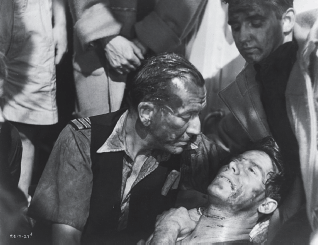Movies and Film: Shooting (in) the War
Shooting (in) the War
Not all movies made in England between 1940 and 1945 revolved around the momentous events of World War II. But most did, whether through their explicit engagement with the struggle itself or in their propagandistic vaunting of the nation's valiant fight against the forces of Fascism. There were essentially two ways of dealing with the war that was on the front of everyone's mind.
Short Cuts
Nol Coward, the great British playwright known for his wry, urbane treatments of upper-class life in plays like Private Lives, also contributed his considerable talents to England's cinematic culture during the war years, collaborating with David Lean on the propaganda film In Which We Serve (1942).
Second Take
American audiences know Gaslight as a classic 1944 MGM production directed by George Cukor and starring Ingrid Bergman. But MGM actually lifted the story wholesale from Thorold Dickinson's 1940 film of the same name. After making its own version, the American studio tried to prevent distribution of the British version by destroying the negative; luckily, though, several prints survived.
Of D-Day and Documentaries
For those on the home front, the massive effort required of England throughout World War II was most effectively reflected, celebrated, and projected through the medium of film documentary. Despite heavy demands on all sectors of the economy, the nation's documentary film industry truly came into its own during the war. Audiences yearning for escapism went to the cinema to watch and listen to news of England's battlefield setbacks and triumphs in newsreels projected at the front of every feature.
England's war documentaries during these years were commissioned and distributed by the so-called Crown Film Unit, a government agency that was responsible for such stirring successes as Humphrey Jennings and Harry Watt's London Can Take It (1940), Jack Holmses's Coastal Command (1942), and many other not-so-subtly-titled pictures. Though this book isn't nearly as concerned with documentary as it is with narrative film, these movies are well worth watching, testifying as they do to a crucial transitional moment in the relationship between filmmakers and the government in England.
True Lies
One of the immediate effects of the sudden explosion in documentary filmmaking was its influence upon feature narrative films. Practically all English story films made about World War II—Michael Powell's 49th Parallel (1941), Leslie Howard's Spitfire (1942), Carol Reed's The Way Ahead (1944), and dozens of others—used documentary footage for battle scenes, cutting from a shot of, say, actual German warplanes flying low over Dover to the silhouette of a paid actor looking up in the sky in concern.
To point out the propaganda-saturated nature of British film during World War II is not to criticize the era's producers and directors for "towing the government line." England's leaders and its people—including its filmmakers—were trying to win a war; all other considerations were secondary, at least for the time being.

A battle scene from Nol Coward and David Lean's In Which We Serve (1942).
Nevertheless, some directors turned purposefully away from the war to make escapist flicks aimed at giving the British public a well-deserved mental break. Even some of these pictures, however, reflected an implicit concern with the psychological implications of modern warfare.
Consider, for example, Thorold Dickinson's Gaslight (1940), the story of a wealthy husband who drives his wife nearly insane by convincing her she's losing her mind. With all the English concern about German spies hiding under every bush, wartime audiences must have identified quite readily with the wife's slow realization that an evil force had infiltrated her home. The movie's "enemy within" theme was virtually guaranteed to strike a chord as England threw its collective might into the war effort, which permanently altered the nature of the nation's film industry.
Excerpted from The Complete Idiot's Guide to Movies and Film © 2001 by Mark Winokur and Bruce Holsinger. All rights reserved including the right of reproduction in whole or in part in any form. Used by arrangement with Alpha Books, a member of Penguin Group (USA) Inc.
To order the e-book book direct from the publisher, visit the Penguin USA website. You can also purchase this book at Amazon.com.







